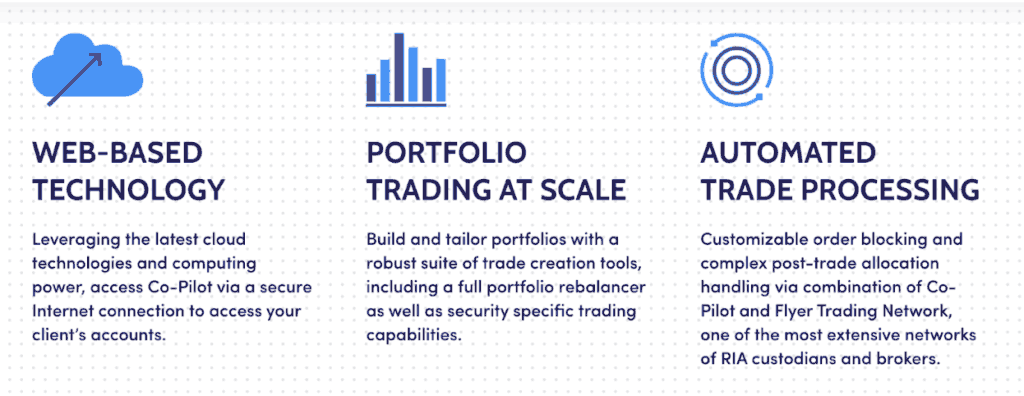Minimize risks, maximize returns. Rinse, repeat.
When the work you do involves the same processes each day, small hiccups in your systems can easily add up – turning what was once considered a small annoyance into a time-intensive (and even costly) problem. And in the time-sensitive and competitive processes that guide a firm’s trading desk, finding efficiency isn’t just a luxury, but a necessity.
That’s why the quickness, accuracy, and adaptability offered by automated trading software is so important for advisors. But with obstacles to integrations, training, costs, and scalability, how can firms successfully adopt new trading software without compromising services during the transition?
Related: Trade Order Management Systems for Financial Advisors
In today’s blog, we’re identifying these common pain points to implementation, as well as five steps you can take during the trading software adoption process to ensure smoother sailing for yourself, the portfolios you manage, and the clients impacted.
Common Pain Points to Implementing New Trading Software
Implementing new trading software can be a double-edged sword, presenting both opportunities for advancement and challenges to overcome.
Take a look at some of the most common pain points of adopting a new trading system below. If you’re currently considering making a change in your tech stack, do any of these sound familiar to your concerns?
Integrations
Compatibility issues can impede the smooth operation of your trading infrastructure. And unfortunately, it’s a common occurrence: NASDAQ reports that “94% of practice management professionals find limited technology integration creates productivity challenges.”
Within your new trading processes, this lack of interoperability with the rest of your firm’s tech stack can often negate any promised efficiencies.
User training
Inadequate training can lead to resistance to change, decreased productivity, and increased errors.
Moreover, different users may have varying levels of proficiency and require tailored training programs.
Scalability
Many off-the-shelf trading software solutions may lack the flexibility, customizability and scalability required to accommodate changing business needs.
Failing to address scalability concerns upfront can hinder your firm’s ability to capitalize on growth opportunities later on.
Cost
Implementing new trading software usually involves several upfront expenses, including licensing fees, implementation costs, and ongoing maintenance. Additionally, there may be hidden costs associated with customization, integrations, and user training.
Balancing the upfront investment with the expected ROI can be challenging, especially for smaller firms with limited budgets.
5 Steps to Ease the Pain of Adopting New Trading Software
With careful planning and execution, firms can minimize disruptions and maximize the benefits when adopting a new trading system. Here are five steps your team can take to avoid common pain points and find efficiency through your new trading platform.
1. Know your needs when choosing your software
Before you choose which trading platform is right for your team, it’s important to consider what specific challenges you need to solve – and what other obstacles may arise as your firm grows. We recommend that you get your leaders together and determine which objectives you hope to accomplish via your new trading system.
For example, firms looking to increase efficiency and save time would benefit from Flyer Co-Pilot’s end-to end trade order management, which includes:
- order upload
- order blocking
- manual order entry
- dynamic order routing
- inclusion of execution instructions
- algorithmic trading
- and more
Look for a solution that fits with all your compliance, integration, and cost needs before you choose a platform to reduce the chance of buyer’s regret down the road.
2. Identify key players and processes from the very start
Successful implementation of a new trading system requires active involvement and buy-in from all stakeholders. Identify key decision-makers and any staff who will be impacted by the change and establish clear communication channels for these individuals – who should they go to in the event of an issue or question?
We also recommend that you develop a detailed project plan with clearly defined timelines, milestones, and responsibilities to keep everyone aligned and accountable.
Related: How Ballast Equity Management Leverage Co-Pilot to Achieve AUM Growth
3. Prep your data, prep it twice
Data is the lifeblood of every financial institution and its trading operation, and ensuring accuracy and integrity is paramount. Before transferring data to the new system, take the time to:
- Identify any inconsistencies, duplicates, or errors in your internal data sets
- Verify compatibility between your existing data formats and the new system’s requirements
- Check with your chosen software provider to explore their data validation processes and quality controls
4. Lean on customization features and vendor support
Every trading firm has unique requirements and workflows, but many trading systems rely on cookie-cutter approaches. Take advantage of platforms that offer customization features to truly fit your specific needs and preferences.
As you implement a new system, leverage vendor support and resources to optimize your system configuration and address any technical challenges or questions that arise.
In addition to our top-tier customer support, Flyer users enjoy access to our online Hub of videos and thought leadership content to ensure they are getting the most out of our Co-Pilot software.
5. Evaluate and adjust as needed
Establish a framework for ongoing monitoring and evaluation to track key performance indicators and identify areas for improvement. Your framework could include:
- Providing ongoing training and support to help users adapt to the new system and maximize their productivity
- Running tests and simulations
- Collecting feedback from end-users and stakeholders
- Conducting meetings to assess whether the software is still effectively serving your firm as your AUM grows
Meet Flyer Co-Pilot: A Faster Solution

With over 500,00 daily trades, 2 million managed investor accounts, and 2.6 billion equity shares traded with Flyer, we have an intimate knowledge of the tools advisors need to create control and freedom in their trading processes.
That’s why we developed Co-Pilot, a comprehensive investment platform that centralizes portfolio management and trade execution in a single multi-asset platform. Co-Pilot automates manual processes and integrates your systems so you can do more while also reducing opportunities for user error.
With our open API partners and electronic processes, you can achieve nearly instantaneous trading operations. You simply create and send your trade orders, and leave the rest to Co-Pilot.
Related: How Asset Managers Can Find Efficiency During Trade Creation
If you’re looking to adopt new trading systems in the near future, understanding common challenges – and the steps you can take to avoid them – is key to success.
Get Started with Co-Pilot
Interested in learning more about how Co-Pilot can lead to more efficient trade creation? Click here to get in touch and schedule a complimentary demo of Co-Pilot today.
